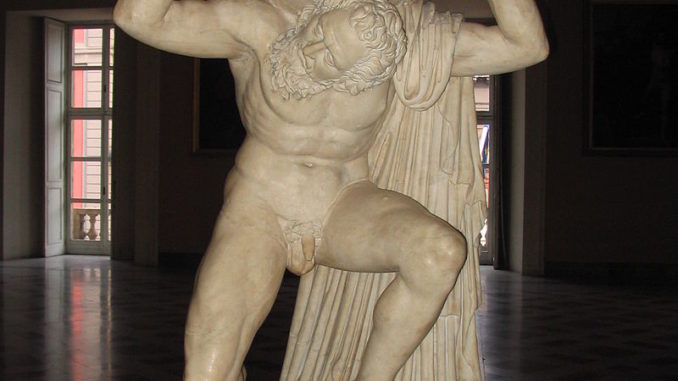
Hello everyone, and welcome back from the holiday season. All filled with food, and had enough presents? Well, then it’s time for another in a series of articles focusing on the Cleric Domains in the Pathfinder Roleplaying Game. The goal for each of these is to provide you with a quick overview of your domain powers, spells, and introduce you to a god or goddess from real-Earth mythology who could be a deity using this particular domain.
All that said, welcome to this week’s article on the domain of: Strength.
The Strength domain is described as “In strength and brawn there is truth—your faith gives you incredible might and power.” – As such, you’re likely to be one that believes in physical strength being the ultimate expression of power. You’re likely to be in good shape (or “country-strong”) and there’s a good chance that a lot of the priesthood believes in the old saying “might makes right.”
The powers granted are “Strength Surge” which allows you to gain an enhancement bonus, for 1 round, equal to ½ your level. Since it’s an enhancement bonus, it doesn’t stack with things like a belt of giant strength or bull’s strength spells, but it can, for a short period, give a bonus that’s higher than any of them.
The second power granted is “Might of the Gods.” It allows you to add your Cleric level as an enhancement bonus to your Strength for a number of rounds equal to your level. The limitation here though is that this does NOT apply to things like damage (which Strength Surge does), but only for Strength-based skills and pure Strength checks. So, it’s not quite as awe-inspiring as it first looks (though a +20 to Strength checks is nothing to scoff at).
Spells:
The spells you get with the Strength domain are as follows:
Enlarge Person
This spell doubles your height and multiplies your weight by 8, meaning that it increases your size by one (from Small to Medium to Large etc.). It also changes your stats, due to the size increase, something which STACKS with things like bull’s strength as it is a size bonus, where these other spells are an enhancement bonus. Finally, it also increases your weapon (and unarmed) damage based on your size, increases either the dice type or the number of dice by one step, as per the below table as per this:
1d3→1d4→1d6→1d8→2d6→2d8→4d6→+1d6 per step beyond this point.
This thankfully also increases the size of your equipment, so that you avoid the “Attack of the 50-foot woman” issue with clothing. It is worth remembering though, that you do NOT change type, so even if you’re the size of a giant, you do not BECOME a giant, so you do not gain a bonus to disguise checks for attempting to be a giant if you’re a humanoid. One thing to remember though is that you ARE quite likely to set off traps that are designed with a max weight before activating (like pit traps) and that most humanoid dwellings are not designed to contain a 10-14 foot tall person who weighs more than 1,000 pounds.
Bull’s Strength
This grants you a +4 enhancement bonus to Strength and increases to the modifier of +2, which can make quite a difference. It has a decent duration of 1 minute/level, and it makes for an excellent “battle-field” buff to damage. Just bear in mind that it does not stack with other enhancement bonuses, though bull’s strength really comes into its own when combined with enlarge person, for a total +6 increase to Strength.
Magic Vestment
Simply put, this makes your armor magical, up to a maximum enhancement bonus of +5. Importantly, you can also enchant normal clothing in this way, allowing you to gain a measure of protection while maintaining a disguise or appearances.
Spell Immunity
This is a very specific spell and one where you benefit from doing your research ahead of time. It makes you completely immune to a specific spell, but ONLY to that one spell, so in a way, it’s extremely powerful, but at the same time incredibly limited. At the point where you get it, you can only choose one spell to be immune to, but you get an extra, as soon as you gain a level, i.e. you become immune to a spell of your choice for every 4 levels you have. So if you know your opponent very well, you should choose his most powerful spells to become immune to. If not, then it’s probably a safe bet to choose something iconic, like fireball.
Righteous Might
Combines all the elements of an enlarge person, bull’s strength and bear’s endurance spells. So you get a whole host of bonuses to your stats, extra damage from being enlarged, and, not only that but damage reduction and an enhancement bonus to your Armor Class on top of it all. In short, one of the best personal buffing spells that you’ll ever be able to get access to.
Stoneskin
This spell sounds great on the surface, but at the level where you can get the spell, it becomes increasingly likely that any attackers have adamantine weapons or do enough damage to power through. However, on those occasions where they have to power through the damage reduction, at least you take that much less damage, making it more likely for you to succeed in your quest. And on those occasions where they do NOT do enough damage or don’t have adamantine weapons (such as when clearing large groups of low-level monsters), this will almost make you feel like a god. Or Achilles at least.
Grasping Hand
This creates a Large-sized hand (i.e. the hand ITSELF is size Large, not the hand of a Large-sized creature), which provides you with cover against the opponent, and which have to be killed to remove. It also slows opponents of less than 2,000 pounds to only half speed, allowing you to halt the progress of many opponents while gaining a significant armor bonus against them. Further, it will always oppose any opponent regardless of light levels or other conditions, interposing itself constantly between you and them. Once they are down, you can move it, as a move action, to a new target and have them suffer the effects. Furthermore, this allows you to grapple opponents as well, with its stats based on your caster level, rather than your ability to grapple. Since it has a free grapple attack each round, you could, at least in theory, completely pacify a spellcasting opponent, as each spell then requires a concentration check to cast a spell. So with a bit of luck, they might fail all of it. (That’s unlikely to happen, but you could see a reduction of upward of 50% fewer spells from that opponent).
Clenched Fist
Clenched fist is basically an upgrade of grasping hand, in that it can now hit people, dealing 1d8+11 points of damage (equal to a Strength of 33), and any targets that fail a Fortitude save are stunned, leaving them unable to act at all (though not helpless). Again, a good spell for locking down a target, but not a primary damage dealer, as the damage dealt is quite low for the level it’s at. It is, however, a free attack that can lock an opponent down, so it’s worth taking along unless you believe that you can kill all your targets in a short amount of time.
Grasping Fist
The top of the fist spells (I’ll be the first to admit that I nearly made a childish joke there. 
New Deity
Please note that the mythology presented here differs a fair bit from the original source material.
Atlas
World-Bearer, Broad Shouldered One, the Earth Titan, the Enslaved
Alignment N
Worshipers craftsmen, those who believe in hard work, slaves, those carrying burdens they cannot share, guards
Cleric Alignments NG, LN, N, CN, CE
Domains: Artifice, Darkness, Destruction, Earth, Protection, Strength
Sub-domains: Ferocity, Night, Rage, Resolve, Solitude, Toil,
Favored Weapon: unarmed strike (or gauntlet)
Symbol: a man holding aloft a planet on his shoulders.
Atlas was one of the first deities, a proto-deity, who was involved in a great war among the gods. Unlike most of the other gods, Atlas remained neutral throughout the conflict, declining to take part in either side, but when one side won, they had to do something about it. He had not committed treason, so they would not kill him or imprison him as they had the others, but neither could they let him go unpunished. As punishment they decided to leverage his great strength, tasking him to keep aloft the great dome of the sky, holding it there during the day. However, as he had not fought against them, he would be allowed to put down the sky regularly but would need to pick it back up again later. As such, the cycle of night and day was born.
His priests follow his example in many ways. They work hard during the day (usually involved in work requiring great strength or endurance, often finding work in construction, helping build houses, or as blacksmiths). His temples are thus great sources of industry within any community, but while most of his priests specialize in one craft or another, that is not a requirement, and especially in smaller communities, it is not unusual to find priests who are capable of doing a bit of everything, like jacks-of-all-trades within craft (i.e. a handyman).
Once darkness falls, however, the priests go from their dour brown leather robes, to exquisitely made white robes, and they either retire early to rest, or, especially on holy days or on the resting days of the week, throw great parties, and consume way too much mead. As a consequence, most of the priests are well-liked and well-known for being hard-working and hard-partying, and many a young reveler has discovered that the priesthood has INDEED perfected a recipe for curing hangovers.


